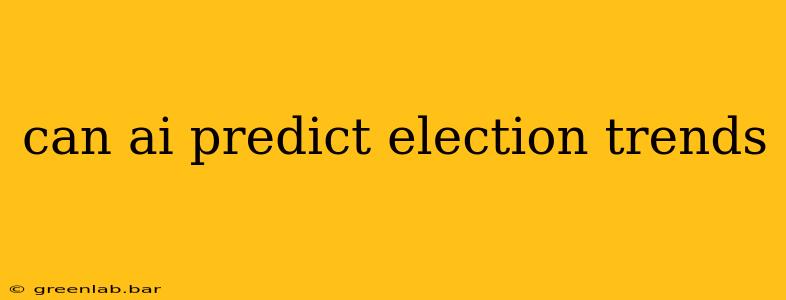The question of whether AI can predict election trends is complex. While AI offers powerful tools for analyzing vast datasets, it's crucial to understand its capabilities and limitations in the volatile world of politics. This article explores how AI is being used in election forecasting, its successes, and its inherent shortcomings.
AI's Role in Election Forecasting: A Data-Driven Approach
AI algorithms, particularly machine learning models, excel at identifying patterns and making predictions based on historical data. In the context of elections, this data can include:
- Voter demographics: Age, location, income, education, and ethnicity are all crucial factors that can influence voting patterns. AI can analyze this data to identify potential swing areas and demographic groups likely to support particular candidates.
- Social media sentiment: AI can analyze millions of social media posts, comments, and tweets to gauge public opinion and identify emerging trends. This provides real-time insights into candidate popularity and potential shifts in voter sentiment.
- Polling data: AI can process and interpret polling data more efficiently than humans, identifying subtle trends and anomalies that might otherwise be missed. By combining polling data with other datasets, AI can refine its predictions.
- News articles and media coverage: AI can analyze news articles and media coverage to understand the narrative surrounding candidates and their campaigns. This allows for the identification of positive or negative media coverage which can impact voter perception.
Successes and Limitations of AI in Election Prediction
Several instances demonstrate AI's potential in predicting election outcomes. AI models have accurately predicted certain local and national election trends with a higher degree of accuracy than traditional methods in some cases. However, it’s crucial to acknowledge significant limitations:
Successes:
- Improved accuracy in specific demographics: AI models have shown success in predicting voting patterns within specific demographic groups, offering more granular insights than traditional polling methods.
- Early identification of trends: AI’s ability to analyze real-time data sources like social media allows for the earlier identification of emerging trends and shifts in voter sentiment.
- Enhanced efficiency in data analysis: AI can process and analyze massive datasets far more quickly and efficiently than human analysts, facilitating faster and more comprehensive analysis.
Limitations:
- Unpredictability of human behavior: Elections are influenced by unforeseen events, unexpected candidate actions, and shifts in public opinion that are difficult, if not impossible, for any AI model to predict.
- Data bias and limitations: AI models are only as good as the data they are trained on. Biased or incomplete data can lead to inaccurate predictions. The availability of reliable and comprehensive data can also be a challenge.
- Overreliance on historical data: AI models primarily rely on past election data. However, significant societal shifts, changing voter demographics, and unprecedented events can render historical data less relevant.
- The "Black Swan" Effect: Unexpected events – what Nassim Nicholas Taleb refers to as "Black Swan" events – can significantly impact election outcomes and are practically impossible to predict using AI or any other methodology.
Conclusion: AI as a Tool, Not a Crystal Ball
AI is a valuable tool for analyzing election data and identifying potential trends. However, it is not a crystal ball capable of perfectly predicting election outcomes. AI should be viewed as one factor among many to consider when analyzing potential election results. Responsible use involves combining AI insights with human expertise, critical thinking, and an awareness of its inherent limitations. Overreliance on AI predictions without considering other contextual factors can lead to inaccurate conclusions and potentially misleading information. The future of election forecasting likely lies in combining the power of AI with the nuanced understanding of human behavior and political dynamics.

